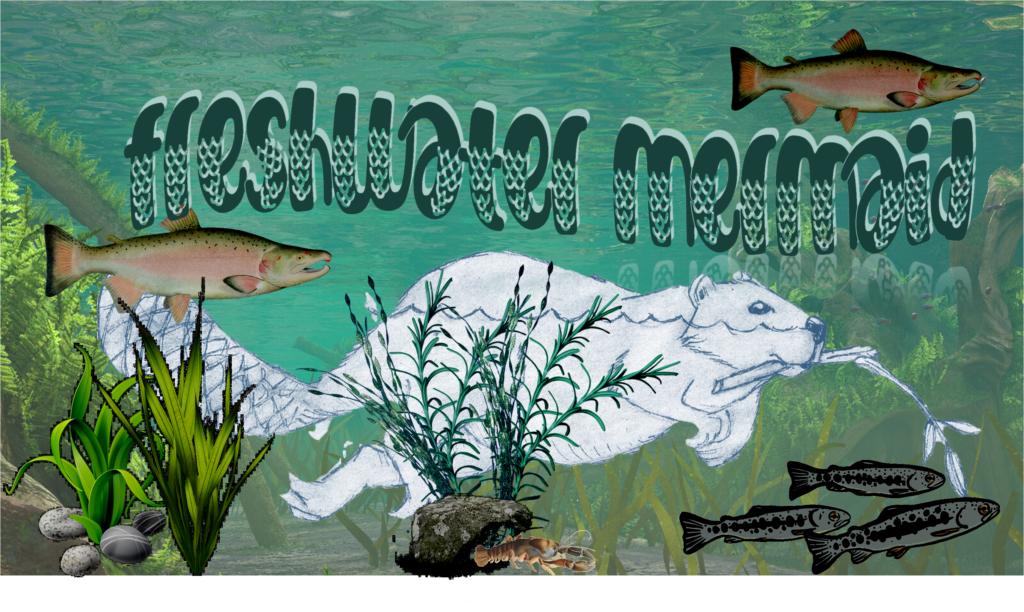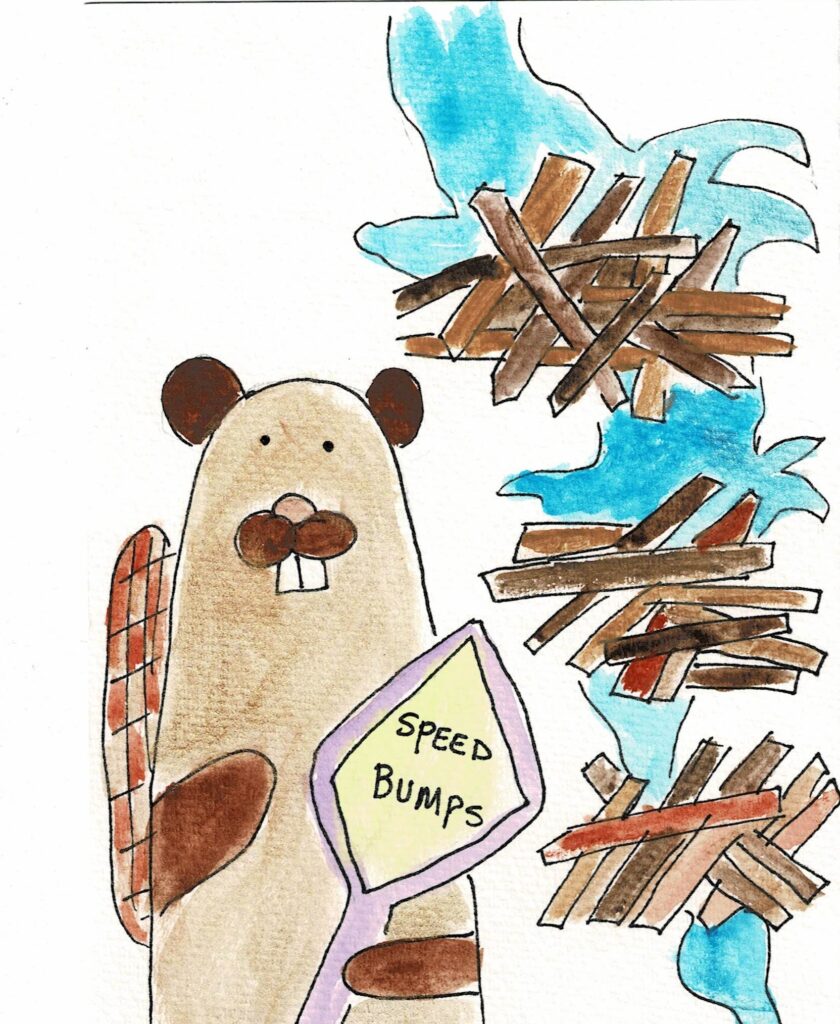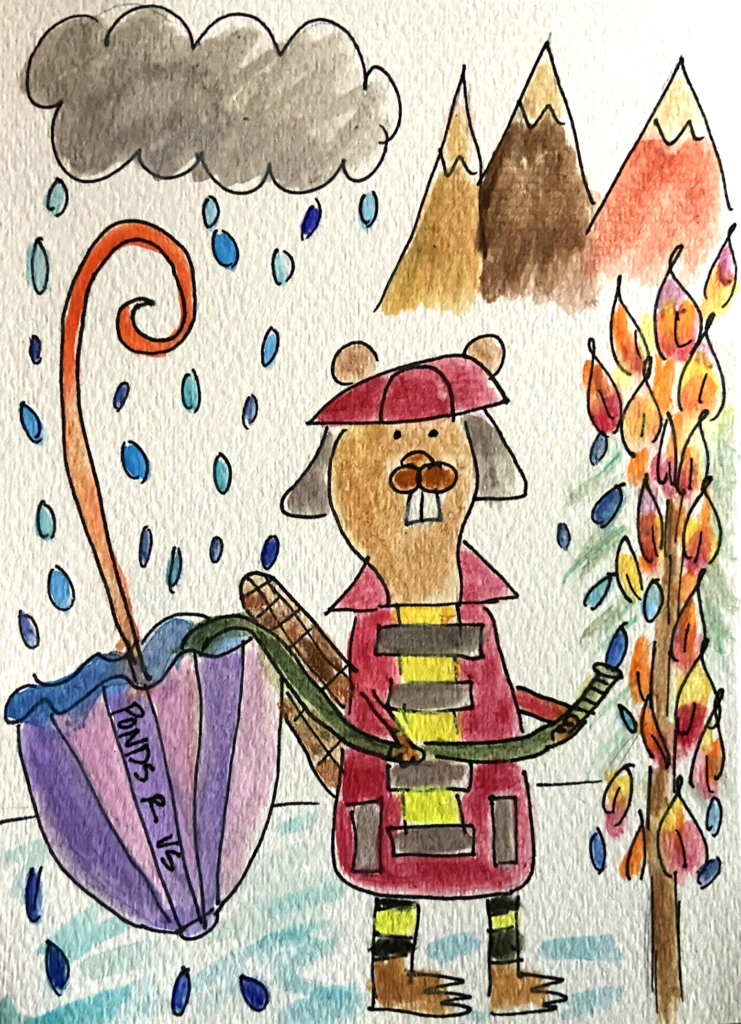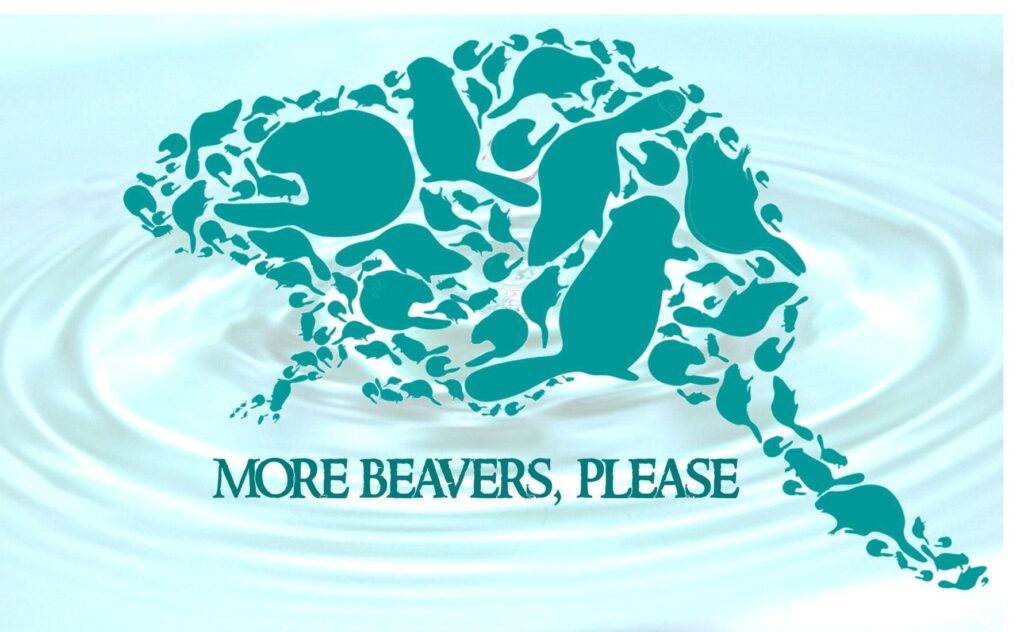How beavers are helping restore wetlands and create buffers against wildfires
Some experts now see beavers — nature’s helpers — as their dams can mitigate the effects of drought and wildfires.

Some experts now see beavers — nature’s helpers — as their dams can mitigate the effects of drought and wildfires.
Sometimes when an idea is just pressing on y0ur mind you have to let it out and see what it wants to turn into. I wish I was a real artist and could make this come to life but you get the idea…

I like the unauthorized nature of bandits because that seems to be the outlaw spirit beaver captured in Martinez. People like bandits. I can even remember being accused of purposely releasing new species into the creek to make people think it was from the beavers….like the mink.
 And mermaids, well people always like mermaids…
And mermaids, well people always like mermaids…
There’s another nice OpEd from Vermont wildlife rehabilitator John Aberth. I ch=ould see this as a series with lots of versions over the year.
 We need every single beaver we can get working for us on the landscape, minimizing the threats of flooding and spread of wildfires. We can no longer afford to waste these animals simply to appease the sportsmen’s lobby.
We need every single beaver we can get working for us on the landscape, minimizing the threats of flooding and spread of wildfires. We can no longer afford to waste these animals simply to appease the sportsmen’s lobby.
Last year, I wrote an opinion piece that asked, “Why are we killing the one animal that can increase wildlife habitat?” (VTDigger, Sept. 13, 2022)
This year, with the recent storms that have raised the specter of Irene and damaged thousands of homes and roadways in Vermont, I ask, “Why are we killing the one animal that can help us fight climate change?”
That animal, of course, is the American beaver. The news lately has been full of stories about how beavers are the new “climate change heroes.” Articles last September in The New York Times and the Los Angeles Times documented how beavers are being reintroduced on ranch lands out West because of their ability to create watersheds that protect against wildfires and store water in times of drought.
Here in Vermont, VPR’s “Brave Little State” program recently aired a segment that featured beavers as a way to restore streams to a more natural, “messier” state that would help mitigate the damage from flooding such as had occurred just a few days before the segment aired.
Good point John. Vermont should be paying very close attention now to everything that can help ease tension on their waterways.
 And yet, it is official policy of the Vermont Department of Fish & Wildlife that beavers can be trapped and killed with no bag limit and during an extraordinarily long season that runs for six months out of the year (October through March).
And yet, it is official policy of the Vermont Department of Fish & Wildlife that beavers can be trapped and killed with no bag limit and during an extraordinarily long season that runs for six months out of the year (October through March).
Consequently, beavers are the second-most-trapped animal in Vermont, with over 1,300 animals killed every year, based on the most recent 10-year average (2011-2021). This is done purely for recreational purposes, with the pelts reserved for private use or else sold, these days to a vanishingly small market.
Although the Department of Fish & Wildlife frequently raises red herrings in defense of trapping, such as that it helps protect roadways and their culverts or that it is used for scientific research and biological sampling, in actual fact recreational trapping is entirely incidental to such efforts.
Nuisance trapping of beavers in defense of roadways is generally conducted by local municipalities and by the Vermont Agency of Transportation, and any biological or research sampling of trapped animals makes up a tiny proportion of the overall killing of beavers.
Honestly I’m not entirely sure I believe that nuisance trapping is soo different than recreational trapping. I’m can well imagine that when some city wants to get rid of its beavers it is perfectly willing to pass along the info to public works cousin Billy who might even get a little reimbursement for his time.
 Surely, the needs and desires of the 645,291 Vermonters who do not trap outweighs those of the 279 active trappers who do, and who make up just 0.04 percent of our population, but who cause inordinate damage to our wildlife.
Surely, the needs and desires of the 645,291 Vermonters who do not trap outweighs those of the 279 active trappers who do, and who make up just 0.04 percent of our population, but who cause inordinate damage to our wildlife.
The impacts of climate change — wildfire smoke from Canada as well as flash flooding and heavy rains — is no longer an abstract threat, but are quite real and are present, here and now. We need every single beaver we can get working for us on the landscape, minimizing the threats of flooding and spread of wildfires. We can no longer afford to waste these animals simply to appease the sportsmen’s lobby that dictates wildlife policy.
When beavers are killed, their dam infrastructures degrade and eventually release or are unable to retain the vast amounts of water that they normally do, thus greatly increasing the risks of flooding. The trapping of over 1,300 beavers every year translates into hundreds of acres of valuable wetlands lost every year, making us more and more vulnerable to the unpredictable and extreme impacts of climate change.
It is high time that the Department of Fish & Wildlife prioritized the well-being of the vast majority of Vermonters, and end the trapping of furbearers. As recent events have made clear, nothing less than the health of our planet, and of those who live here, is at stake.
Nicely put John. A live beaver is more useful to Vermont than a dead one. I wish that every state was starting to get that idea.
What a fantastic report from NBC news. The Napa beavers are getting the eyes and respect they deserve; Watching this report I am glowing with satisfaction and filled with the thought that it’s too bad that Supervisor Brad Wagenknecht who had the vision to make it possible and welcome beavers is now retired and unable to get credit. Or that the hard working crew that struggled for two decades to restore the Napa River could see the fruits of their labors.
Come to think of it and that the Martinez beavers who were probably Napa’s grandparents can’t see their hard work come to fruition. There are chapters to this story I haven’t even heard,. It’s been a long road to get here at all.
In California, where beavers were once trapped into near extinction and considered nuisances, they’re now being framed as potential land stewards, saviors in a time of tumultuous weather swings. The state is now looking for ways to harness their unique skills as tools in dealing with the impacts of climate change. The California Natural Resource Agency recently even included beavers in its climate smart strategy.
“In places where we’re trying to restore wetlands, meadows, salmon streams, riparian range lands,” said Lindquist, “we can actually partner with the beaver to accelerate the pace of that restoration.”
It’s not to say these toothy workers aren’t without their issues — beavers are known to cause issues by plugging culverts, felling trees and causing flooding by their damming.
“There are some places where it’s really all efforts to coexist have been exhausted,” said Lundquist. “In those cases we don’t want to kill those beavers, we’d like to put them to use somewhere else.”
Dolman added the busy rodents also ply their services for free and beyond the red tape of permits.
In Napa Creek, the trio of young beavers put on a show for those gathered on the sidewalks and in the parking lot abutting the creek, swimming in and out of their lodge, strutting up the hillside to pull down willow branches which they dragged back to the water to chew. Dolman followed the scene through a pair of powerful binoculars.
“Willow leaf salad for dinner in downtown Napa,” he whispered. “It’s like the perfect Slow Food.”
Our good friend Suzanne Fouty, formerly a hydrolgist of the USFS teamed up with Bill Ripple professor of Ecology at OSU to publish this op ed. I know you’ll want to see it and pass it around.

Fish and wildlife are declining due to habitat loss. Major river basins, such as the Colorado and Klamath river basins, find themselves faced with water shortages and rising conflicts. Various salmon populations are facing extinction as their numbers continue to decline.
To improve conditions, we need abundant beavers building abundant beaver dams and habitat on our federally managed public lands, the source of much of our water and strongholds of biodiversity.
To get abundant beavers, dams and habitat, their survival and dispersal rates must increase. Closing these public lands to beaver trapping and hunting would do both.
Why is a closure needed? Most beaver take occurs in the winter months, when beaver pelts are at their best (a pelt brings $10 to $20). Winter is also the beaver’s breeding and pregnancy season. Entire families can be removed in a single season, suppressing population growth and future dispersal.
An excellent point. Trapping season is the very time the population is about to increase. Of course Depredation season is year-round.

The loss of beavers leaves dams unattended. As dams fail and are not repaired, ponds drain, water tables drop, habitats unravel and benefits are lost.
What type of benefits is lost? Beavers are nature’s firefighters and drought busters. Their dams, ponds and wetlands store carbon, provide valuable salmon-rearing habitat, diminish flood peaks and create high-quality wildlife habitat.
Beaver habitat can also improve water quality and help sustain summer flows, important to cities, towns, farmers and ranchers.
But these benefits require abundant wetlands and vibrant stream systems, which are currently scarce on public lands. This scarcity is due in large part to ongoing legal trapping and hunting of beaver, which continues to suppress population growth, dispersal, and beaver dam and habitat creation.
At present, the state wildlife agencies set beaver trapping and hunting seasons, with the exception of California and New Mexico, which now protect beavers. The primary focus of the state wildlife agencies is to serve trappers and hunters because these user groups contribute to agency funding through equipment purchases via the Pittman-Robertson Act and trapping and hunting licenses.
Well I wouldn’t go so far as saying California protects beavers, but I get your point.
Depending on the state, the beaver trapping/hunting season ranges from a few months to year-round. In most places, there are no limits to the number of beavers that can be killed, and reporting is minimal.
This narrow state agency management focus is limiting the productivity and biodiversity of our public lands at a time when climate changes are accelerating. We need to let our congressional representatives know that beavers must be protected on federally managed public lands so they can help restore the many thousands of miles of degraded streams that currently exist on these lands.
In the process of stream restoration, they will create numerous wetlands, resulting in major environmental and economic benefits such as natural wildfire breaks, micro reservoirs that sustain streamflows during drought and dampen flood peaks, and vastly improve fish and wildlife habitat.
Congress, and multiple rulings by the Supreme Court, have given the federal government the constitutional and statutory authority to manage fish and wildlife on federally managed public lands. Given that most state wildlife agencies refuse to protect beavers, the federal government needs to step in if we are to maximize wildfire and drought readiness on public lands.
I’m not sure that congress is more po[ular than beavers are in Oregon or anywhere else for that matter?
Protecting beavers on our federally managed public lands is a nature-based climate solution that will lead to major stream restoration and wetland creation, and bring tangible benefits to our communities. The wildfire and drought clocks are ticking down.
Let’s protect beavers on our federal public lands so they can finally swim into action for the benefit of all. Go Beavs!
Go Suzanne! You message needs to reach a lot of ears and eyes. Let’s hope this starts something good.
